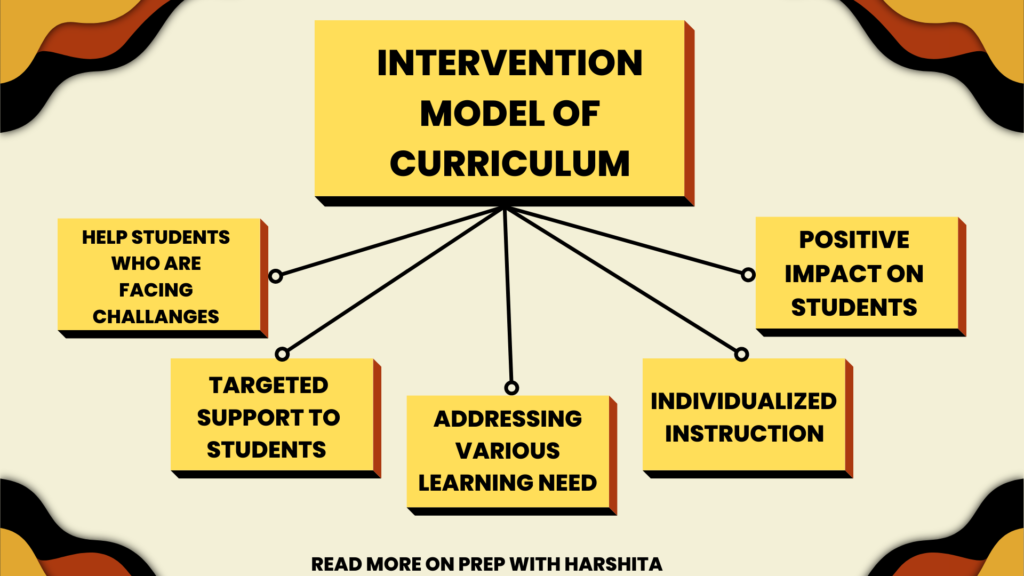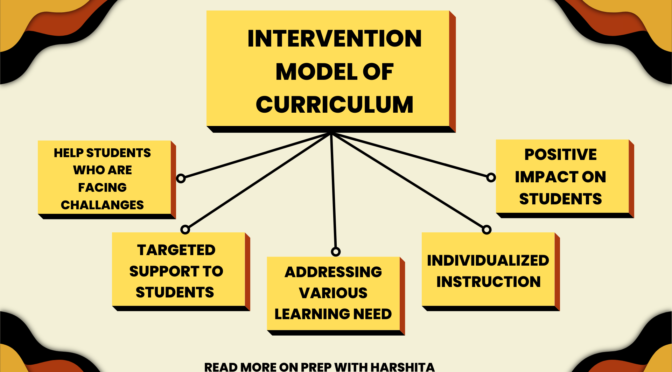The intervention model of curriculum is an approach that is designed to help students who are struggling with specific academic or behavioral challenges.
- This model involves identifying the individual needs of each student and providing targeted interventions to address those needs.
- This model of a curriculum design approach that focuses on identifying and addressing specific learning needs and challenges of students.
- This model recognizes that students have different learning styles, abilities, and needs, and thus, require different types of support and interventions to achieve academic success.
- This Model is designed to provide targeted support to students who need additional assistance to achieve academic success.
There are several benefits to using the intervention model of curriculum, including:
- Individualized instruction: The intervention model of curriculum provides individualized instruction tailored to the specific needs of each student. This personalized approach can help students to better understand the material and improve their academic performance.
- Targeted interventions: The interventions provided through this model of curriculum are designed to target specific areas where students need additional support. By focusing on the areas where students need the most help, teachers can help students to improve their understanding of the material and build confidence in their abilities.
- Improved academic performance: By providing targeted interventions and individualized instruction, the intervention model of curriculum can help students to improve their academic performance. Students who receive this type of support are more likely to achieve their learning objectives and perform better on assessments.
- Increased engagement and motivation: Students who receive targeted interventions and individualized instruction are more likely to be engaged and motivated in their learning. When students receive the support they need to succeed, they are more likely to stay interested in the material and be motivated to continue learning.
- Positive impact on self-esteem: The intervention model of curriculum can help to improve students’ self-esteem and confidence in their abilities. By providing targeted interventions and individualized instruction, students can see that they are making progress and feel more confident in their ability to succeed.
- Equity and inclusion: This model can help to promote equity and inclusion by ensuring that all students have access to the support they need to succeed. By providing targeted interventions and individualized instruction, teachers can help to close achievement gaps and ensure that all students have the opportunity to achieve their full potential.
Features of Intervention Model of Curriculum:
- Individualized instruction: This model of curriculum is designed to provide individualized instruction to each student based on their unique needs and challenges. This may involve adapting the curriculum to meet the specific learning style, pace, or ability of each student.
- Diagnostic assessment: This model of curriculum typically involves an initial diagnostic assessment to identify the specific learning needs and challenges of each student. This assessment helps teachers and curriculum designers to identify the areas where students require additional support and to design targeted interventions to address those needs.
- Targeted interventions: This model of curriculum is designed to provide targeted interventions to address the specific needs and challenges of each student. These interventions may include one-on-one instruction, small-group instruction, tutoring, mentoring, or other forms of academic support.
- Progress monitoring: This model of curriculum involves ongoing monitoring of student progress to ensure that students are making progress towards their learning goals. Teachers and curriculum designers track student progress through formative assessments, observations, and other methods. It ensures that interventions are effective and that students are achieving their learning objectives.
- Data-driven decision-making: This model is based on data-driven decision-making, which involves using data to identify student needs, design interventions, and monitor progress. This approach helps to ensure that interventions are targeted and effective. Also, It ensures that students are making progress towards their learning goals.
- Continuous evaluation: This Model involves continuous evaluation of intervention strategies to determine their effectiveness and to identify areas for improvement. This evaluation helps teachers and curriculum designers to refine their interventions and to ensure that they are meeting the needs of each student.
Steps of Intervention Model of Curriculum:
- Assessment: Teachers or curriculum designers first assess the needs and challenges of each student through diagnostic testing or other forms of assessment.
- Identification of Learning Needs: Based on the assessment results, teachers or curriculum designers identify the specific learning needs and challenges of each student.
- Design of Intervention Strategies: Teachers or curriculum designers then design and implement targeted interventions to address the identified learning needs. These interventions may include individualized instruction, small-group instruction, tutoring, mentoring, or other forms of academic support.
- Monitoring Progress: Teachers or curriculum designers monitor the progress of each student and adjust the intervention strategies as necessary to ensure that the student is making progress towards their learning goals.
- Evaluation: At the end of the intervention period, the effectiveness of the intervention strategies is evaluated to determine if they have met the desired outcomes.
Also Read : Outcome Based Integrative Model

Also Visit : Prep with Harshita


One thought on “Intervention Model of Curriculum”